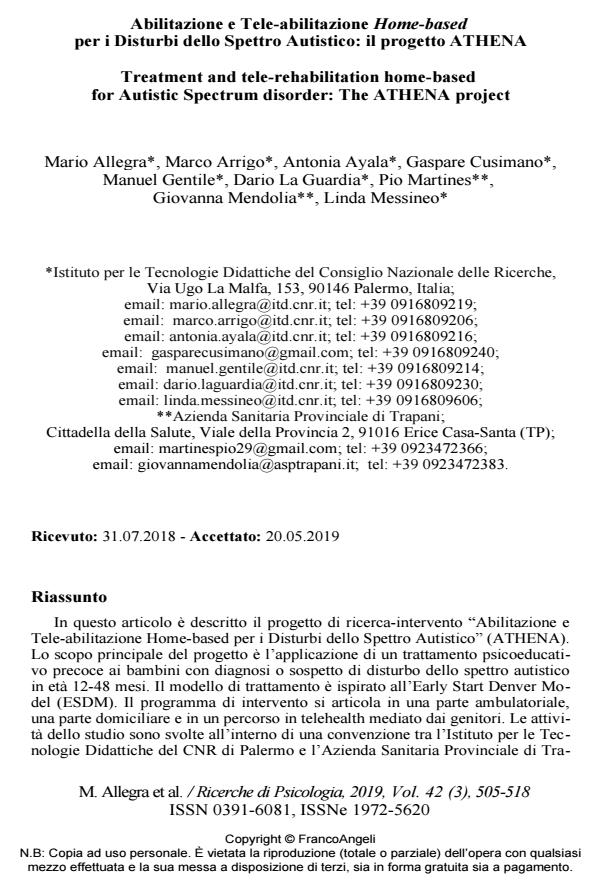Treatment and tele-rehabilitation home-based for Autistic Spectrum disorder: The ATHENA project
Journal title RICERCHE DI PSICOLOGIA
Author/s Mario Allegra, Marco Arrigo, Antonia Ayala, Gaspare Cusimano, Manuel Gentile, Dario La Guardia, Pio Martines, Giovanna Mendolia, Linda Messineo
Publishing Year 2019 Issue 2019/3
Language Italian Pages 14 P. 505-518 File size 189 KB
DOI 10.3280/RIP2019-003004
DOI is like a bar code for intellectual property: to have more infomation
click here
Below, you can see the article first page
If you want to buy this article in PDF format, you can do it, following the instructions to buy download credits

FrancoAngeli is member of Publishers International Linking Association, Inc (PILA), a not-for-profit association which run the CrossRef service enabling links to and from online scholarly content.
This article describes guidelines for the project "Home-based therapy and Tele-treatment for Autistic Spectrum disorder" (ATHENA). The main objective of the project is to provide psychoeducational treatment to children as young as 12-48 months with autism spectrum disorders or a pattern of development that shows risks for developing autism. The treatment model is inspired by the Early Start Denver Model (ESDM). The intervention program is divided in three parts: one that takes place at the outpatient clinic, another that occurs in the child’s home, and another telehealth part that is mediated by the parents. The activities included in the study are part of an agreement between the Institute of Tecnologie Didattiche of Consiglio Nazionale Ricerche and the Azienda Sanitaria Provinciale of Trapani. The project consists of low-intensity tele-treatment where the activities and therapy take place in the child’s natural environment. The use of technology in this project aims to encourage the empowerment of the family and is thought to promote treatment sustainability as well as reduce costs and stress that would occur if the child were to be taken to clinics. The use of telehealth in neurodevelopmental disorders has significantly increased in recent years in all areas where a reliable internet connection enables contact with patients in rural and isolated areas or where a home-based therapy is more appropriate.
Keywords: Autism spectrum disorders, telehealth, empowerment, Early Start Denver Model, early intervention.
- A Parent-Mediated Telehealth Program for Children with Autism Spectrum Disorder Manuel Gentile, Linda Messineo, Dario La Guardia, Marco Arrigo, Giuseppe Città, Antonia Ayala, Gaspare Cusimano, Pio Martines, Giovanna Mendolia, Mario Allegra, in Journal of Autism and Developmental Disorders /2022 pp.5285
DOI: 10.1007/s10803-022-05482-6
Mario Allegra, Marco Arrigo, Antonia Ayala, Gaspare Cusimano, Manuel Gentile, Dario La Guardia, Pio Martines, Giovanna Mendolia, Linda Messineo, Abilitazione e Tele-abilitazione Home-based per i Disturbi dello Spettro Autistico: il progetto ATHENA in "RICERCHE DI PSICOLOGIA " 3/2019, pp 505-518, DOI: 10.3280/RIP2019-003004